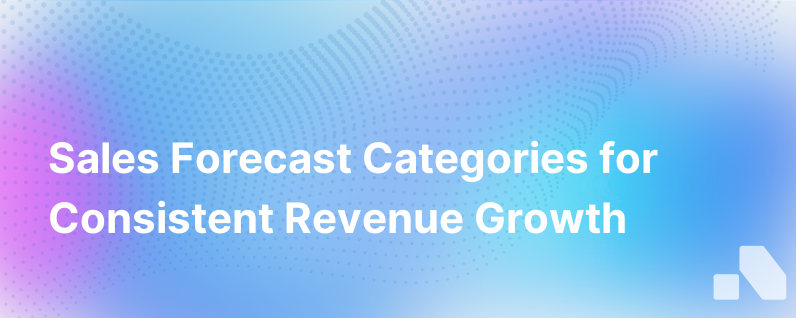
Predicting future revenue streams is both an art and a science—a discipline that significantly impacts a company's strategic planning and operational decisions. Reliable sales forecasting enables effective resource allocation, informed strategy formulation, and more confident investment into growth initiatives. However, to achieve a dependable forecast, sales organizations need to define and use consistent sales forecast categories.
This detailed exposition will uncover how defining sales forecast categories can lead to a more reliable revenue stream, the key categories for sales forecasting, and best practices for incorporating them into your sales process.
Understanding Sales Forecast Categories
Sales forecast categories are classifications used to segment opportunities based on their likelihood to close. These categories help sales teams standardize the qualification and prioritization process of their deals. While categories may vary among organizations depending on unique sales processes or industry specifics, there are several commonly used ones, which include:
- Commit: Deals in this category are those the sales rep is certain will close within the forecast period. They typically have all the necessary signatures or are in the final stages of procurement.
- Best Case: Opportunities that are likely but not certain to close. They might be contingent on a key decision or event but are beyond the initial stages of the sales cycle.
- Pipeline: This category is for deals that are in mid to late stages of the sales pipeline but are not advanced enough to fall under 'Best Case'. They still require significant sales efforts to progress.
- Leads: These are early-stage opportunities. They have been qualified as potential buyers but are not actively engaging in a buying cycle.
These categories help sales teams focus their efforts and provide a basis for leaders to assess pipeline health and predict revenue.
The Importance of Sales Forecast Categories
By using sales forecast categories, companies can:
- Better gauge the progress of various sales opportunities.
- Allocate resources appropriately to deals with higher closure probabilities.
- Identify any potential shortfall in the pipeline and make proactive adjustments.
- Communicate with stakeholders about expected revenues with greater precision.
How to Define Sales Forecast Categories for Your Company
To drive a reliable revenue stream using sales forecast categories, it is crucial to align them with your specific sales process, customer journey, and historical data. Here’s how to define and apply these categories:
-
Align with the Sales Process: The sales forecast categories should reflect major milestones in the sales pipeline. Mapping categories to stages allows for consistency and clarity.
-
Leverage Historical Data: Past performance data is invaluable in defining realistic forecast categories. Analyze win rates, average deal duration, and conversion rates to inform your categories.
-
Incorporate Qualitative Insights: Integrate sales rep input and customer feedback. Your front-line team's insights can provide depth to numbers-only forecasting.
-
Opt for Simplicity and Clarity: Categories must be clear and manageable. Complex categorizations can lead to confusion and inconsistent application by sales reps.
-
Iterate as Necessary: Revisit and adjust forecast categories as your sales process and market conditions evolve.
Best Practices for Implementing Sales Forecast Categories
Once defined, the challenge lies in consistent implementation. Here's how to ingrain sales forecast categories into everyday sales operations:
- Train Sales Teams: Education and training ensure that sales reps understand each category and apply them correctly to their pipeline.
- Enforce Discipline: Consistent application is key. Enforce the use of these categories across the board to avoid subjective forecasting.
- Use Technology for Enforcement: Tools like CRM systems can be configured to require forecast category selection and justification, maintaining discipline in categorization.
- Monitor and Adjust Forecasts Regularly: Regular review meetings can help refine forecasts based on the latest information and shifts in the pipeline.
- Ensure Leadership Involvement: Active participation from sales leadership legitimatizes forecast categories and emphasizes their importance.
A closer look at 'Commit' and 'Best Case' Categories:
'Commit' Category Best Practices
- Strong Validation: Opportunities should only be labeled 'Commit' if all aspects have been thoroughly validated, including customer need, budget, authority, and timing.
- Documentation: Ensure that all commitments are backed by written confirmation from the buyer or evidence of significant progress towards the deal closure.
- Sales Rep Accountability: Reps should be held accountable for their 'Commit' forecast to maintain integrity in the forecasting process.
'Best Case' Category Best Practices
- Assessment of Risks: Sales reps should identify potential deal-breakers or risks that could impede the deal from moving to 'Commit.'
- Development Plans: Reps need action plans for moving 'Best Case' deals forward, with clear next steps and timelines for progression.
- Regular Review: 'Best Case' deals should be reviewed frequently to assess any movement or changes in deal confidence.
Conclusion
Defining clear, straightforward, and actionable sales forecast categories is crucial for startups and established enterprises alike. These categories, when enforced and utilized properly, provide the framework for a reliable forecasting system that ensures better visibility and more predictable revenue.
Organizations can harness the true predictive power of sales forecasting, a process made scalable and sustainable with modern CRM platforms that integrate AI-driven insights. Platforms like Aomni offer intelligent tools that assist sales reps in categorizing and forecasting deals, thereby saving time and improving forecast accuracy.
Incorporating robust sales forecast categories lays the groundwork for smarter, more dynamic, and ultimately more successful sales strategies. Start refining your sales forecast categories today to build a more resilient and revenue-driven future.